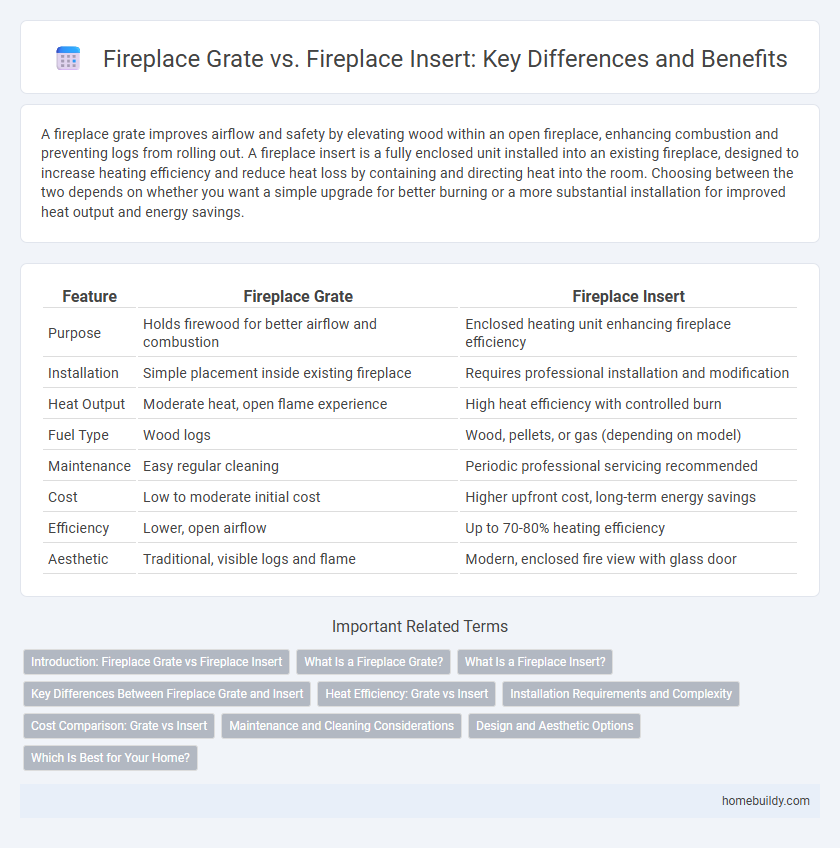A fireplace grate improves airflow and safety by elevating wood within an open fireplace, enhancing combustion and preventing logs from rolling out. A fireplace insert is a fully enclosed unit installed into an existing fireplace, designed to increase heating efficiency and reduce heat loss by containing and directing heat into the room. Choosing between the two depends on whether you want a simple upgrade for better burning or a more substantial installation for improved heat output and energy savings.
Table of Comparison
| Feature | Fireplace Grate | Fireplace Insert |
|---|---|---|
| Purpose | Holds firewood for better airflow and combustion | Enclosed heating unit enhancing fireplace efficiency |
| Installation | Simple placement inside existing fireplace | Requires professional installation and modification |
| Heat Output | Moderate heat, open flame experience | High heat efficiency with controlled burn |
| Fuel Type | Wood logs | Wood, pellets, or gas (depending on model) |
| Maintenance | Easy regular cleaning | Periodic professional servicing recommended |
| Cost | Low to moderate initial cost | Higher upfront cost, long-term energy savings |
| Efficiency | Lower, open airflow | Up to 70-80% heating efficiency |
| Aesthetic | Traditional, visible logs and flame | Modern, enclosed fire view with glass door |
Introduction: Fireplace Grate vs Fireplace Insert
A fireplace grate is a metal frame designed to hold wood logs in place for efficient burning and improved airflow, enhancing heat output. In contrast, a fireplace insert is a self-contained unit installed inside an existing fireplace to increase heating efficiency, often featuring advanced technologies like sealed doors and blowers. Understanding the distinctions helps homeowners choose between traditional open fires and modern, energy-efficient heating solutions.
What Is a Fireplace Grate?
A fireplace grate is a metal frame designed to hold firewood securely above the hearth, allowing air to circulate underneath and promote efficient burning. Unlike a fireplace insert, which is a sealed, often gas or electric unit installed within the fireplace opening to improve heating efficiency, a grate works with traditional open wood-burning fireplaces. Grates enhance airflow and combustion, resulting in hotter fires and reduced smoke inside the home.
What Is a Fireplace Insert?
A fireplace insert is a sealed steel box with a glass front designed to fit inside an existing masonry fireplace, improving energy efficiency by radiating heat directly into the room. Unlike fireplace grates, which hold logs for open burning, inserts often use gas, wood, or pellets with controlled combustion to maximize warmth and reduce emissions. Inserts provide enhanced safety and heat output while reducing air leakage compared to traditional grates.
Key Differences Between Fireplace Grate and Insert
A fireplace grate is a metal frame designed to hold firewood or coal securely within an open hearth, allowing for optimal airflow and efficient burning. In contrast, a fireplace insert is a sealed, self-contained unit installed into an existing masonry fireplace to enhance heating efficiency and reduce emissions. While grates facilitate traditional wood-burning, inserts often feature advanced technology like sealed glass doors and blowers, converting fireplaces into effective heat sources.
Heat Efficiency: Grate vs Insert
A fireplace insert significantly improves heat efficiency by enclosing the fire and allowing for controlled air flow, which maximizes heat output and minimizes heat loss compared to a standard fireplace grate. Fireplace grates provide basic support for logs and air circulation but lack the insulation and heat retention features of inserts, resulting in lower overall heat efficiency. Installing a fireplace insert can boost heating efficiency by up to 70%, whereas grates primarily aid combustion without substantial heat conservation.
Installation Requirements and Complexity
Fireplace grates require minimal installation, simply placed inside the existing firebox to hold logs and improve airflow. Fireplace inserts demand significant modifications, including precise fitting into the fireplace opening, venting adjustments, and often professional installation to ensure safety and efficiency. Inserts provide enhanced heating performance but involve higher complexity and installation costs compared to basic grates.
Cost Comparison: Grate vs Insert
A fireplace grate typically costs between $50 and $150, making it a more budget-friendly option for enhancing firewood airflow and combustion. In contrast, a fireplace insert, which involves installation and often requires professional labor, ranges from $1,000 to $3,000 or more depending on fuel type and features. The significant price difference reflects the insert's added efficiency, heat output, and safety benefits compared to the simple metal grate design.
Maintenance and Cleaning Considerations
Fireplace grates require regular removal of ashes and soot to prevent buildup and ensure proper airflow, making cleaning straightforward with routine brushing and vacuuming. Fireplace inserts, being enclosed units, often have glass doors that need frequent cleaning to remove soot and creosote deposits, along with periodic inspection of ventilation systems to maintain efficiency. Both options demand consistent maintenance, but inserts typically involve more detailed upkeep due to their complexity and sealed design.
Design and Aesthetic Options
Fireplace grates offer a traditional, open design that enhances the natural look of wood-burning fireplaces, showcasing flames and logs with minimal obstruction. Fireplace inserts provide a more modern and streamlined aesthetic, often featuring glass fronts and sealed units that blend seamlessly into contemporary interiors. Choosing between the two depends on desired visual impact, with grates emphasizing rustic charm and inserts favoring clean, efficient design integration.
Which Is Best for Your Home?
A fireplace grate enhances airflow and promotes efficient wood burning within an open hearth, making it ideal for traditional wood fireplaces. Fireplace inserts, designed for increased heat output and energy efficiency, fit inside existing fireplaces and often come with sealed glass doors to reduce heat loss. Selecting between a grate and an insert depends on your home's heating needs, aesthetic preferences, and whether you prioritize ambiance or optimized warmth.
Fireplace grate vs Fireplace insert Infographic

 homebuildy.com
homebuildy.com